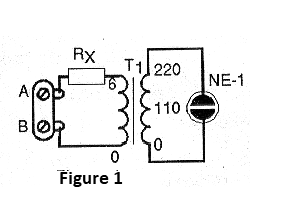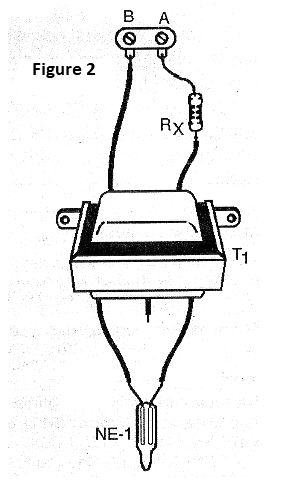For science fairs and demonstrations it can both be used to show how sound can be converted into light in an energy transformation experience as well as to explain the working principle of transformers and neon lamps. An important detail of this circuit is that the power it uses to power comes from the amplifier itself and so it does not need to be connected to batteries or other power source.
OPERATION
The current variations that correspond to the sound are applied to the low voltage winding of a small transformer. In this way the induction of high voltage occurs in its other winding and this voltage has the same variations of the sound that is being reproduced.
This voltage is sufficient to light a small neon bulb that needs at least 80 volts for this. In this way the small lamp starts blinking in the same rhythm as the music that is played on the sound system.
ASSEMBLY
In figure 1 we have the complete diagram of the neon rhythmic micro light system.

In figure 2 we have the actual appearance of the assembly.

The transformer and the resistor can be installed inside a small plastic housing. The value of the resistor depends on the power of the amplifier to be used, according to the following table:
Power per channel = Rx
0 to 2 watt = without resistor
2 to 5 watt = 4.7 ohm x 0.5 W
5 to 10 watt = 10 ohm x 1 W
10 to 25 watt = 22 ohm x 1 W
25 to 50 watt = 47 ohm x 2 W
If your system is stereophonic you can mount a rhythmic light like this for each channel. The transformer is of any type used in primary voltage sources of 110 V or 220 V and secondary with any voltage between 4 and 12 volt and current between 50 mA and 300 mA. The neon lamp is common NE-2H or equivalent.
TEST AND USE
The circuit is connected to the speakers or outputs of each channel of the amplifier. Adjust the volume of the amplifier so that the lamp blinks along with the sound being played.
WHAT TO EXPLAIN
Check how the transformer works and explain how it increases the output voltage of the amplifier so you can power a neon lamp that needs 80 V to light up.
Explain why variations in brightness occur with sounds.
SUGGESTIONS
If you put two electrodes for a person to hold and connect them to the point where the neon lamp is (the neon lamp should be removed), we will have the transmission of the sound sensation through the skin in the form of shocks. This feeling should be carefully controlled by the volume of the amplifier.
T1 - Transformer - see text
NE-1 - common neon lamp
Rx - resistor - see text
Several:
Housing for mounting, antenna / ground strip, wires, solder, etc.



